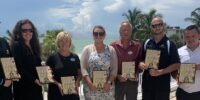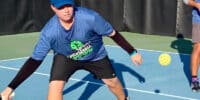Discover More About our Sanibel Sea Turtles
It has been an amazing Sea Turtle Season so far here on Sanibel Island! It’s been a joy watching the teams working to protect the nests and monitor hatchings. As a part of the Sanibel Captiva Conservation Foundation Adopt A Beach Program, we promise to make our beach sea turtle and sea life-friendly and, in return, enjoy an annual report of all of the documented nesting activity and rare bird sighting on our beaches.
In honor of this landmark season, we wanted to share more turtle insight with all of you. Kelly Sloan of the SCCF was kind enough to be our turtle guide.
What types of sea turtles nest on Sanibel?
Loggerheads are the most common and we have been seeing increasing numbers of Green Turtles in recent years. However, very rarely, we will see a Kemp’s Ridley or Leatherback nest.
How long does it take a mother turtle to make and lay her nest? Is it true that turtles return to where they were born to lay their nests, year after year?
It takes a loggerhead hatchling around 25-30 years to reach maturity. They use the Earth’s magnetic field to return to the same general region where they were born to nest. Interestingly, an individual female doesn’t typically nest in two consecutive years – she takes a year or two off in between nesting seasons.
Do nests always hatch at night? Why?
Yes. Nests typically hatch at night when it’s not as easy to get dehydrated from the hot sun and there are fewer predators. This is an evolutionary trick that gives the hatchlings the best chance at survival.
What % of hatchlings make it to maturity?
Sea turtles face a lot of threats and only about 1 in 1,000, 0.1%, make it to adulthood.
What obstacles do hatchlings have to overcome?
One of the biggest threats to hatchlings in Florida is artificial lighting. When hatchlings emerge from the sand, they naturally crawl towards the brightest point on the horizon, which has historically been the reflection of the moon and stars off the sea. With coastal development, there has been an increase in artificial lights, which can cause hatchlings to go landward and become dehydrated, taken by predators, or even attempt to cross busy roads. Even headed in the right direction, hatchlings run the risk of falling into holes or getting trapped in garbage left on the beach. Every beachgoer can help by filling in holes at the end of the day, removing furniture and trash at night, and turning the lights out after dark!
After they hatch and get into the sea, what do they do?
These were once referred to as the “lost years” because so little was known about what they do when the hatchlings reach the open ocean. However, researchers have discovered a way to track these little turtles and learn more about their behavior.
The basic picture is this: Loggerhead hatchlings head out to sea to avoid fish, sharks, and other predators. Once off the continental shelf, they eventually end up in a current, called the North Atlantic subtropical gyre. As they mature, their focus becomes on feeding and they’ll eat a variety of prey, such as mollusks and crustaceans, hydrozoans, sargassum (sea weed), jellyfish and fish eggs.
Why is protecting nests so important? How does SCCF help to assure nests are protected? Can individuals adopt a stretch of beach and how can they do that?
Sea turtles are some of the most charismatic species on the planet and their population is considered vulnerable. Healthy oceans need sea turtles. Sea turtles are a “keystone species”, which means they are an important part of their environment and influence other species around them.
SCCF monitors the beaches of Sanibel and Captiva every morning during sea turtle season to look for new nesting activity. Our team of volunteers mark the nests and cover the eggs with screens to prevent depredation. We have several research projects aimed at learning more about the turtles on our beaches so we can better protect them.
We share the beach with sea turtles and every single person can make a difference by turning off the lights, filling in holes at the end of the day, and removing any furniture and trash from the beach.
We also offer an Adopt A Beach program that allows people to become actively involved in sea turtle and shorebird conservation. Learn more today!
Photo and video provided by SCCF







